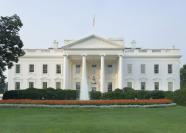Obama Vows to Rid the Red Tape
Odds are tough in an election year

In his 2012 State of the Union address, President
Obama announced his intention to sign an executive
order to cut through “red tape” that hinders
infrastructure construction.
After a lengthy discussion about U.S. energy,
including the need to develop clean energy, Obama
briefly mentioned transmission.
“Building this new energy future should be just one
part of a broader agenda to repair America’s
infrastructure,” he said, naming a power grid that
“wastes too much energy” along with “crumbling roads
and bridges.”
To facilitate the repair of such infrastructure
systems, Obama said he would sign an executive order
in the next few weeks to clear away “red tape” that
slows down construction projects.
“But you need to fund these projects,” he said.
“Take the money we’re no longer spending at war, use
half of it to pay down our debt, and use the rest to
do some nation-building right here at home.”
The thrust of Obama’s discussion about energy,
though, was the nation’s investment in clean energy.
Clean energy should not suffer at the hands of the
oil industry, he said. The era of taxpayer
incentives for the oil industry should give way to
an era of incentives for clean energy.
“We’ve subsidized oil companies for a century,”
Obama said. “That’s long enough. It’s time to end
the taxpayer giveaways to an industry that rarely
has been more profitable, and double-down on a clean
energy industry that has never been more promising.”
According to a 2009 Environmental Law Institute
study, U.S. fossil fuel subsidies from 2002 to 2008
totaled $72 billion, while during the same period,
renewable subsidies totaled $29 billion, over half
of which supported corn ethanol. Fossil fuels
included petroleum and its byproducts, natural gas
and coal products. Renewable energies included wind,
solar, biofuels, biomass, hydropower and geothermal.
During his speech, Obama called for an “all-out,
all-of-the-above” energy strategy that includes a
diversified U.S. generation portfolio.
Domestic natural gas supplies are enough to last the
United States 100 years, he said, adding that public
research dollars played an important role in the
development of shale gas extraction technology.
Though the resource has been there to exploit for
decades, adequate shale gas technology has taken
decades to develop.
“Our experience with shale gas, our experience with
natural gas, shows us that the payoffs on these
public investments don’t always come right away.
Some technologies don’t pan out; some companies
fail,” Obama said, apparently indirectly referencing
the bankruptcy of Solyndra.
The Obama administration has come under fire for its
$528 million loan to the failed solar technology
company.
“But I will not walk away from the promise of clean
energy. … I will not cede the wind or solar or
battery industry to China or Germany because we
refuse to make the same commitment here,” he
continued, later calling for the passage of clean
energy tax credits.
Obama, in his American Recovery and Reinvestment Act
of 2009, provided a three-year extension of the
production tax credit (PTC) for electricity
generated from wind, geothermal, biomass,
hydropower, landfill gas, waste-to-energy and marine
facilities. The extension ends Dec. 31. The tax
credit for solar energy expires in 2016.
Edison Electric Institute President Tom Kuhn in a
statement issued the day after the address said
Obama’s call for an “all of the above” strategy is
something the U.S. power industry has been
advocating for years, and reiterated that generation
provided from coal, natural gas, nuclear and
renewable energy are all needed.
“The need for diversity carries over into the
transportation sector, as well,” Kuhn noted. “The
steady adoption of plug-in-electric vehicles gives
Americans the choice to fill up at the pump or plug
in at home. The extremely low operating costs of
PEVs—which run on the equivalent of $1 per gallon of
gasoline, make a compelling case for moving to
greater use of electricity as a transportation
fuel.”
Many ideas espoused need Congress support and that
will be difficult in a presidential election year.
Rosy Lum is chhief Analyst for TransmissionHub, an
Energy Central publication:
www.transmissionhub.com
Copyright © 1996-2011 by CyberTech, Inc. All rights reserved.
To subscribe or visit go to: http://www.energycentral.com
To subscribe or visit go to: http://www.energybiz.com